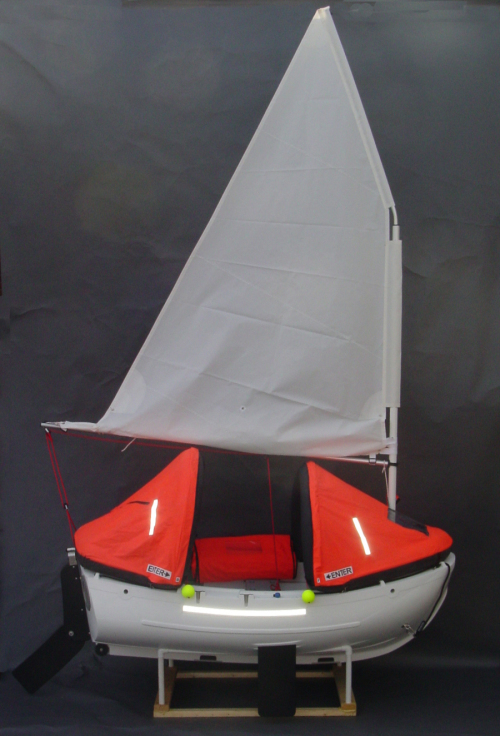Portland Pudgy Lifeboat FAQ
It’s a widespread notion that it’s safest to float passively in an inflatable life raft, having signaled with your EPIRB, and wait for rescue. This is sometimes the best thing to do, and the Portland Pudgy lifeboat’s sea anchor will allow you to remain relatively stationery, if that is your decision. However, many experts in sea rescue agree that passively waiting is often NOT the best idea. For one thing, your EPIRB is not a guarantee of rescue. The EPIRB is a great invention, no question, and every blue water sailor should have one. However, they’re easy to lose, and if you have one, it must work, and the battery must be charged. It’s also very important to recognize that in many parts of the world, search and rescue is simply not available.
In the dynamic Portland Pudgy lifeboat, you can sail to safety. Many experts on survival at sea emphasize that this is critically important. As Steve Callahan, who spent 76 days adrift on a life raft, points out, “Most of a long survival voyage is spent drifting slowly in moderate weather.” He goes on to say that if he had had a “dynamic” (proactive) life raft/boat, he “would have sailed to safety in a mere six or seven days” (from The Liferaft: Don’t Leave Your Ship Without It).
A fascinating video, Survivorman: Season 1, Episode 9, Lost at Sea, shows the frustration a sailor feels as his inflatable life raft drifts in circles a few miles from the islands he sees in the distance. Here is a link to an account by Survivorman’s consulting marine expert of what he saw when getting a life raft for the show. And here is an excerpt from his story:
“The production company [of Survivorman] made a deal with a popular life raft company for the use of one of their four person life rafts; but they [the life raft company] backed out at the last minute suggesting that a five day test of a life raft was unrealistic…their representative said ‘in this day and age anyone anywhere should expect rescue in two days’. I reckon he doesn’t read the news nor books much.”
What are the Portland Pudgy safety dinghy’s survival system components?
The basic lifeboat system includes the basic boat plus the exposure canopy, the sea anchor, and the boat cover. These are required for an effective system. We also recommend the pump, boarding ladder/fender, and safety harness eyes. You must supply your own ditch bag. Add the sail kit to the lifeboat boat system, and the Pudgy becomes a dynamic lifeboat that can be sailed to safety. For detailed information, see Lifeboat Components.
Note that we do not supply a ditch bag with the lifeboat. It is of utmost importance that you make up your own ditch bag and stow it safely inside the hull storage compartment. The Pudgy lifeboat has a huge amount of storage chamber space for provisions and other safety items. Here is a link to the Equipped to Survive website, where you can get detailed information on creating a ditch bag. (A discussion of the poor quality of ditch bags supplied with life rafts can be found at Latitude 38 and here). Several videos you can find on the Internet (including Survivorman: Season 1, Episode 9, Lost at Sea) show the waterlogged, meager contents of the ditch bag supplied and poorly packaged by a life raft company.)
Can you sail Portland Pudgy lifeboat with exposure canopy in place?
You can unzip the middle section of the exposure canopy and set up the sail kit with the the sail reefed above the exposure canopy. This should only be done in relatively calm seas, once the danger of rough weather is past. The boat can be sailed with the exposure canopy in place and the middle section open.
Can you row or motor Portland Pudgy lifeboat with exposure canopy in place?
You can pre-set the exposure canopy so that the middle section is zipped off and the CO2 cylinders disarmed. This lets you continue to use the Pudgy as an everyday tender with the canopy in place. You can also row with the inflated canopy in place and the middle section removed.
You can use a small motor by loosening the straps at the stern of the canopy.
It is a good idea to reserve your canopy for use in an emergency. In the future we will be developing a bimini and lightweight cover for camping.
How is the survival system self-contained?
An extremely important feature of the Portland Pudgy lifeboat is that it is a self-contained unit. In an emergency, all of the equipment is contained within the boat. All of the survival system equipment, including the exposure canopy, sea anchor, boat cover, sail kit, and oars, stows neatly inside the double walls of the hull. And there is still room for provisions, fishing equipment, water maker, ditch bag, etc..
- The three sections of the exposure canopy fit inside three stuff bags, which can be stowed through the cockpit hatches. The exposure canopy can also be pre-set on the gunwales.
- The boat cover can be stowed through a cockpit hatch or pre-set over the pre-set exposure canopy.
- The sea anchor can be stowed through a cockpit hatch or pre-set under the bow seat.
- The sail kit’s mast telescopes down, the gaff folds down next to it, and the sail is furled around it, to form a package that fits into the sail bag and stows through the sailing dinghy’s transom hatch. The rudder and short leeboards stow under the stern seat. The long leeboards stow under the middle seat.
- The oars pull apart and can be stowed through the transom hatch.
- The electrical system’s pole light stows through the transom hatch.
- The solar panel stows through a cockpit hatch.
Is it necessary to have the exposure canopy tested and repacked?
With the Portland Pudgy lifeboat system, you can test the exposure canopy yourself. Standard inflatable life rafts must be unpacked, tested, and repacked periodically. This is a costly process, and the owner must trust the competence and reliability of the tester. As one Pudgy owner observes:
“Most people have no clue what their life raft looks like when it is inflated. I would rather work with something that I have personally inspected and know.” Rolland T., MI
Here’s a link to a Pudgy owner’s blog describing his Pudgy lifeboat test. Here’s a link to another, where the Pudgy owner describes his problems with his old life raft in dealing with leaks, repacking, etc. (funny). Finally, have a look at this account by a consulting marine expert of what he saw when getting a life raft for a reality TV show.
It is crucial that you check all your safety equipment regularly.
Important points for proper maintenance of your Portland Pudgy exposure canopy:
- Check exposure canopy valves for corrosion and replace if necessary.
- Check your exposure canopy inflation system at least once a year by inflating the tubes manually or by using CO2 cylinders. Either method is effective, but of course using the CO2 cylinders is faster (they can be used only once). You can order new CO2 cylinders from Portland Pudgy, Inc. The CO2 cylinders have a shelf life of seven years.
- Be very careful to avoid puncturing or tearing the canopy when you store it, whether in the side walls of the Pudgy lifeboat, or anywhere else.
Can you preset the exposure canopy so it is ready in the event of an emergency?
Yes. The exposure canopy is designed so that you can preset it. You should cover it with a boat cover so that the inflation cords are not pulled accidentally. See Lifeboat Components for more information.
Can the Pudgy be washed overboard?
In a roll or in heavy seas, any lifeboat or life raft canister can be washed overboard if not fastened onto the deck properly. The Portland Pudgy lifeboat should be securely fastened down with strong webbing passed through the built-in through holes just below the gunwales. The through holes are an intrinsic part of the boat, and cannot be broken off. Obviously, the webbing should also be attached to strong points on the mother boat (preferably through-bolted stainless steel attachment points). Your lifeboat should, in addition, be attached to a long tether that is fastened to a strong point on the mother boat. This tether can be untied or severed when necessary (normally when the mother boat is sinking, in danger of exploding, or poses some other extreme danger, and all passengers and crew are aboard the lifeboat).
See the Lifeboat section of the Portland Pudgy Owners’ Manual for more information.
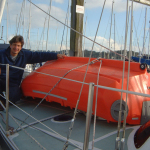
Deploying: How difficult is it to deploy Portland Pudgy compared to inflatable life raft?
The Portland Pudgy lifeboat, a rugged, solid boat, is heavier than most life raft canisters, at about 128 lb. The survival equipment adds more weight. However, if you have your Pudgy set up on your deck so that it is easily accessible, and if you fit the life lines with pelican hooks so that you can disconnect the line and slide the Pudgy off the deck, it can be easily deployed in an emergency. Bear in mind the old adage that you should not board your lifeboat (or life raft) until you have to step up to it from your mother boat. You will not be lifting the Pudgy and throwing it down into the water as much as sliding it into the water.
The exposure canopy and sea anchor can be pre-set for emergency use. The exposure canopy inflates in about 17 seconds after the lanyard is pulled. It uses two inflation chambers, each with a CO2 cylinder and a high-quality valve. (The valves are approved by the Navy for their one-man life raft.) You can preset the exposure canopy and the sea anchor so they are ready to be deployed quickly. For detailed information on the sea anchor and exposure canopy, see the Portland Pudgy Owner’s Manual.
With regard to deploying life rafts—unfortunately, there are many tragic stories of life rafts being deployed and not inflating. They can even explode. The Pudgy is already a boat; you don’t have to hope that it inflates. Another difficulty in deploying life rafts is that in severe storm conditions they have been known to become airborne (and thus impossible to board) and to flip upside down. In addition, if life rafts hit the water upside down, they will inflate upside down. Watch this video: not easy to right a capsized life raft. This video (around :35) gives an idea of how easy the Pudgy is to right. (Note that the Pudgy is in a shallow tank in the video and the men are standing, so it is easier for them to capsize the boat than if they were afloat in deep water.)
You can find videos on the Internet (including Survivorman: Lost at Sea) showing quite vividly both the potential tragedy of a life raft deflating immediately after inflating, as well as the difficulties of the raft inflating upside down. There are many other sources on the Internet about difficulties in inflatable life raft deployment. Here are a few: Valve Failure, Poor Service, Seafish Industry Authority. In this Cruisers Forum page, life raft failures are discussed.
Boarding: Is it easier or more difficult to get into the Portland Pudgy lifeboat from the water?
 The Portland Pudgy lifeboat is much easier to get into from the water than a life raft is. Inflatable life rafts are notoriously difficult to get into. (See this video of able-bodied men struggling to get into a life raft in calm water.) There are many stories of heavy people or people with poor upper body strength or who are just exhausted or weakened by hypothermia being unable to board a life raft.
The Portland Pudgy lifeboat is much easier to get into from the water than a life raft is. Inflatable life rafts are notoriously difficult to get into. (See this video of able-bodied men struggling to get into a life raft in calm water.) There are many stories of heavy people or people with poor upper body strength or who are just exhausted or weakened by hypothermia being unable to board a life raft.
When you board the Portland Pudgy lifeboat from the water, even without the boarding ladder, the procedure is as follows: you get in position on the side of the boat at the exposure canopy entrance, holding onto a grabline, the gunwale, or the boarding ladder. Tip the boat toward you so that you can reach in and grab a hand-hold in the middle seat (the hand-holds in the middle seat allow it to function as a horizontal ladder). Kick out and pull yourself in over the gunwale. The boat tips down as you do this, but it will not capsize. One of our testers, a woman in her late fifties with a damaged, weakened shoulder, was sure that she would be unable to get in from the water, and was amazed at how easy it was. We had another tester who weighed 275 pounds climb in from the side easily, without causing the Pudgy to ship water or capsize. The boarding ladder makes it even easier: it acts like a stirrup that gives you “a leg up.”
Ballast Bags: Don’t you need ballast bags to keep the lifeboat stable?
Ballast bags on life rafts are not as effective as many sailors assume for the following reason: there is no resistance to a bag of water when it is in the water because it weighs the same as the surrounding water. You only get resistance when the bag is lifted out of the water, and by the time this happens, the life raft is already tipped very steeply and can be capsized easily by wind or waves. The Pudgy lifeboat uses a sea anchor to reduce the risk of capsize.
The USCG did a test of life rafts in hurricane force winds (created using helicopters and a C130 airplane). They tested several large life rafts (most with ballast bags), and all of them, with the exception of a 25-person buoy life raft, were quickly and easily capsized, trapping the occupants under the collapsing floor of the raft. Somewhere in cyberspace there is a video showing several life rafts in the test, and all but one of them flipping. Here’s a link we found to a much shorter excerpt showing just the buoy life raft and another life raft.
Bear in mind that a buoy life raft, while probably superior to the non-buoy life raft, still takes several minutes for the water chamber to fill. Until then, it is just as vulnerable to capsize as a non-buoy life raft. In addition, a buoy life raft, like any life raft, could hit the water upside down and inflate upside down, which obviously makes it impossible for the water bag to fill until it is righted. The first episode of Survivorman: Season 1, Episode 9, Lost at Sea) shows how just about everything that can go wrong with a life raft very well might.
Sea Anchor: What kind of sea anchor does the Portland Pudgy lifeboat use?
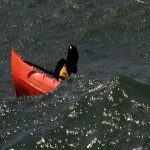
The sea anchors that come with most life rafts are notoriously flimsy and inadequate. The Pudgy lifeboat uses a substantial and ruggedly-built Fiorentino sea anchor, made especially for Portland Pudgy. The sea anchor attaches to the Pudgy’s rugged bridle, which in turn is hooked to two attachment points that are spaced on either side of the bow, for triangulation. The stainless steel attachment points are very solid and cannot tear off (as is possible on fabric life rafts, in which case they can rupture the raft). Zack Smith of Fiorentino Para-Anchor tested the Pudgy lifeboat with its sea anchor in 12 foot seas and dangerous currents off the California coast, and was very happy with its performance.
A Dutch crew from the magazine Zeilen tested the Portland Pudgy as a lifeboat last year in the treacherous waters of the North Sea (sailing it 20 miles to shore), and they make it a point in their article to talk about how pleased they were with the performance of the Pudgy with the sea anchor. The bow held firmly into the oncoming waves and wind, thus greatly reducing the risk of capsize.
A related topic: There are several sturdy attachment points for safety harnesses in the Portland Pudgy, including optional stainless steel safety harness eyes which are bolted to the wall of the boat and have strong backing plates. Any safety harness attachment point in a fabric life raft is a site for a potential tear in the life raft.
Capsize: What happens in the event of capsize?
All boats and life rafts can capsize. When life rafts capsize, the occupants can be trapped under the floor of the raft. It is necessary for life raft passengers to exit the raft to turn it over.
The Portland Pudgy is a solid boat that is heavier than its exposure canopy. The bottom-heaviness makes the Pudgy want to right itself, and in fact, the Pudgy with the inflated canopy is self-righting when empty. The CO2-inflated 6-inch tubes of the Pudgy act as roll bars in rough seas. If the Pudgy capsizes with two adults inside and the inflated exposure canopy in place, the added 400-plus pounds of buoyancy in the canopy make the Pudgy lie partially on its side; the passengers can right the boat by shifting their weight or waiting for wave action to right it. Even lying partially on its side, because of the deep rigid floor of the Pudgy, a large domed air chamber is formed inside the partially-capsized boat (unlike the fabric floor of an inflatable life raft, which can trap and suffocate passengers if capsized).
By the way, even without the exposure canopy in place, the capsized Pudgy floats high in the water and is very easy to right using the handholds in the keel, and because of the thickness of the double-wall hull, it picks up little or no water (no sitting in a swamped boat). This can be life-saving. Hypothermia is a major cause of death in emergencies at sea. See Yacht Tender/Dinghy FAQs.
How big/comfortable is the Portland Pudgy lifeboat?
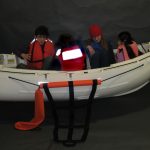
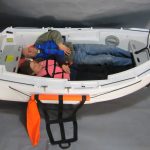

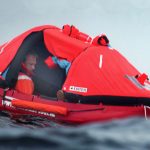
Roomy cockpit with flat floor. The Pudgy has 16.1 square feet of floor space. The USCG requires 16 square feet for a four person life raft. The Portland Pudgy’s middle seat is removable, and the flat floor is 6 feet two inches long, designed so that two people can comfortably stretch out to sleep.
Easy to bail and keep dry. Unlike a life raft, the Pudgy’s floor can be kept dry. Sitting and lying in salt water for prolonged periods can cause serious sores and infection.
Rigid, insulated floor. Because of the double wall thickness and the foam under the floor, the floor is not as cold as in most life rafts, and because it’s a rigid boat, you can’t feel things like shark fins and fish bumping up against the floor.
Storage room: The Pudgy has a huge amount of secure storage room inside the double hull. This hull storage is accessed via five water-tight hatches. In addition to the Portland Pudgy survival system components, you can keep drinking water, provisions, your ditch bag, fishing supplies, a first aid kit, and much more inside.
 Electrical system. You can get the optional electrical system, which is rechargeable with a solar panel (or standard recharger). It has a navigation light, a red chart reading light, it illuminates the built-in compass, and it can power a GPS, torch, EPIRB, fishfinder, or other devices. (For more information see Owner’s Manual.)
Electrical system. You can get the optional electrical system, which is rechargeable with a solar panel (or standard recharger). It has a navigation light, a red chart reading light, it illuminates the built-in compass, and it can power a GPS, torch, EPIRB, fishfinder, or other devices. (For more information see Owner’s Manual.)

